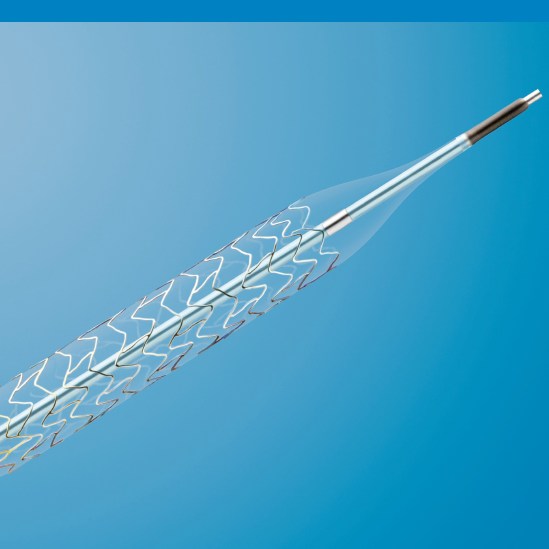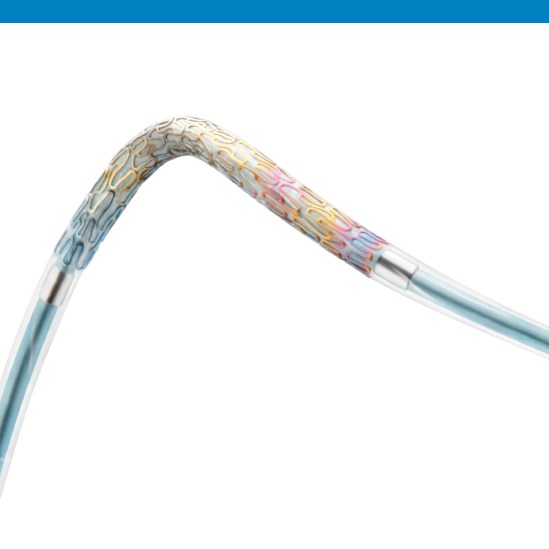Product Details

Excellence in Stent Design
- Wedge-shaped transitions at the stent ends allow for consistent scaffolding throughout the entire length of the stent.
- Helical meanders give flexibility to the stent for excellent delivery while leaving a smooth crimped profile.
- Longitudinal connectors provide stability for optimal scaffolding and support without sacrificing flexibility.

Thermal Crimping Technology
Thermal crimping techniques have been developed to ensure secure stent retention forces as well as a smooth, low crossing profile.
Ultra-Thin Struts Design
Struts of only 60 μm2 result in exceptional flexibility and deliverability of the stent in even the most challenging anatomy.
Improved Stent Surface Biocompatibility
proBIO silicon carbide coating acts as a diffusion barrier, sealing the bare metal surface and reducing ion release. In vitro studies have shown up to a 96% reduction of allergenic metal ions3 when the stent surface is coated with silicon carbide.
By providing a barrier against ion release, the silicon carbide coating creates a surface that reduces platelet aggregation while facilitating endothelialization.1
Innovative Stent Delivery System
The stent delivery system is built on trusted balloon technologies and provides excellent deliverability and placement accuracy. The soft tapered balloon tip eases crossing lesions and 1 mm balloon markers enable precise stent placement. Furthermore the Enhanced Force Transmission (EFT) shaft adds pushability and kink resistance.
Technical Data
| Stent | |
|---|---|
| Stent | Balloon-expandable |
| Stent material | Cobalt chromium (L605) |
| Strut thickness | ø 2.0 - 3.0 mm: 60 μm (0.0024"); ø 3.5 - 4.0 mm: 80 μm (0.0031"); ø 4.5 - 5.0 mm: 120 μm (0.0047") |
| Stent coating | proBIO (amorphous silicon carbide) |
| Sizes | ø 2.0 - 5.0 mm; L: 9 - 15 - 20 - 30 - 40 mm |
| Delivery System | |
|---|---|
| Catheter type | Rapid exchange (Rx) |
| Recommended guide wire | 0.014" |
| Tip | Soft, tapered, colored |
| Balloon markers | 2 swaged markers |
| Shaft | Hydrophilic coating (distal shaft) |
| Usable length | 140 cm |
| Nominal pressure (NP) | 9 atm |
| Rated burst pressure (RBP) | 16 atm (2.0 - 4.0 mm); 14 atm (4.5 - 5.0 mm) |
Compliance Chart
| Balloon Diameter x Length (mm) | |||||||||||||||||||
|---|---|---|---|---|---|---|---|---|---|---|---|---|---|---|---|---|---|---|---|
| Nominal Pressure | atm4 | 9 | 9 | 9 | 9 | 9 | 9 | 9 | |||||||||||
| (NP) | ø (mm) | 2.00 | 2.50 | 3.00 | 3.50 | 4.00 | 4.50 | 5.00 | |||||||||||
| Rated Burst Pressure | atm4 | 16 | 16 | 16 | 16 | 16 | 14 | 14 | |||||||||||
| (RBP) | ø (mm) | 2.33 | 2.83 | 3.42 | 4.07 | 4.65 | 5.11 | 5.63 | |||||||||||
Ordering Information
Contact
1 Rzany A, Schaldach M. 2001. Progress in Biomedical Research 2001 May: 182-194. ² 2.0 - 3.0 mm stents.
2 2.0 mm - 3.0 mm stents
3 BIOTRONIK data on file.
4 1 atm = 1.013 bar


